Abstract
High concentrations of fetal bovine serum induced colony formation in soft agar by anchorage-dependent, nontransformed mouse AKR-2B and rat NRK cells. The colony-stimulating activity in fetal bovine serum was precipitated by 45% saturated ammonium sulfate and migrated in molecular sieve chromatography as a single peak of activity in the 10,000-15,000 molecular weight range. The colony-stimulating activity was heat and acid stable and was destroyed by trypsin and dithiothreitol, indicating the activity is due to a polypeptide that requires disulfide bonds for biological activity. No competition for binding to the epidermal growth factor receptor was associated with the colony-stimulating activity. Isoelectric focusing revealed activity in the pI 4-5 range. The colony-stimulating activity in serum appeared to be of platelet origin because platelet-poor plasma and platelet-poor plasma-derived serum contained little activity, whereas acid/ethanol extracts of bovine and human platelets had potent colony-stimulating activity. Chromatography of platelet extracts on Bio-Gel P-60 revealed peaks of AKR-2B colony-stimulating activity in the 12,000 and 20,000 molecular weight ranges. The other biological and chemical properties of the platelet colony-stimulating activity were the same as those for the serum activity. The data indicate the presence in serum of a platelet-derived growth factor(s) with properties similar to those of the transforming growth factors.
Full text
PDF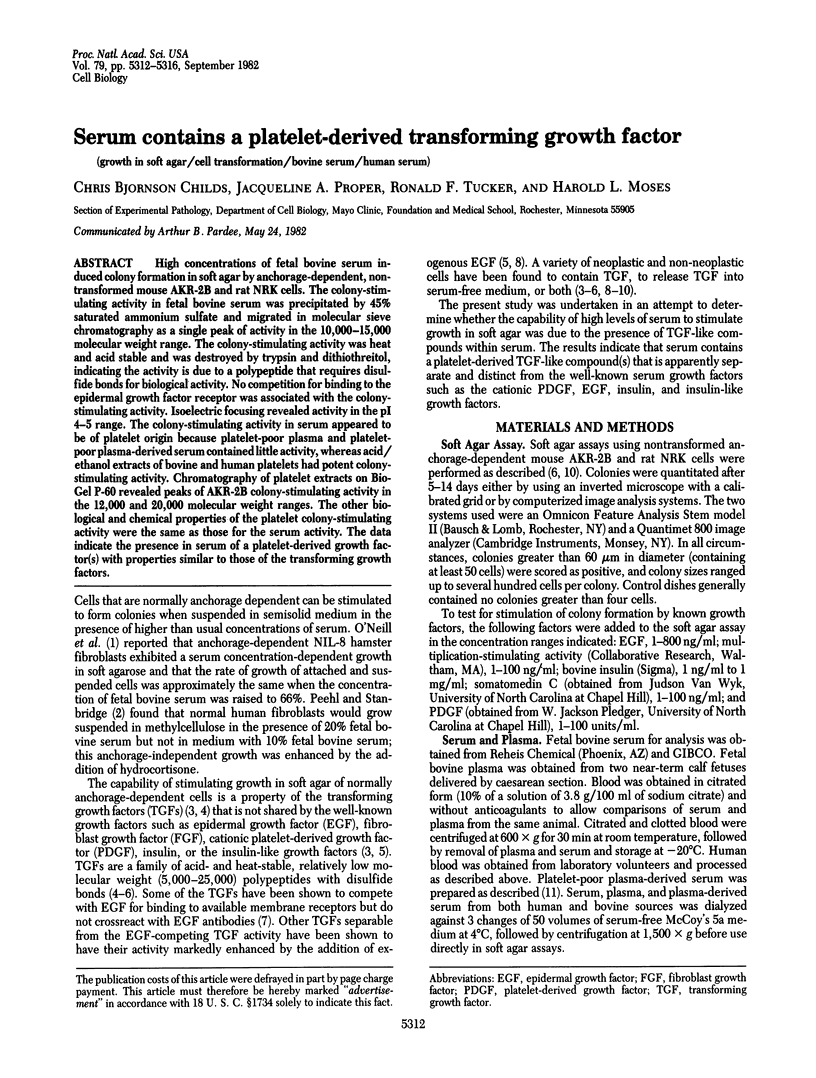
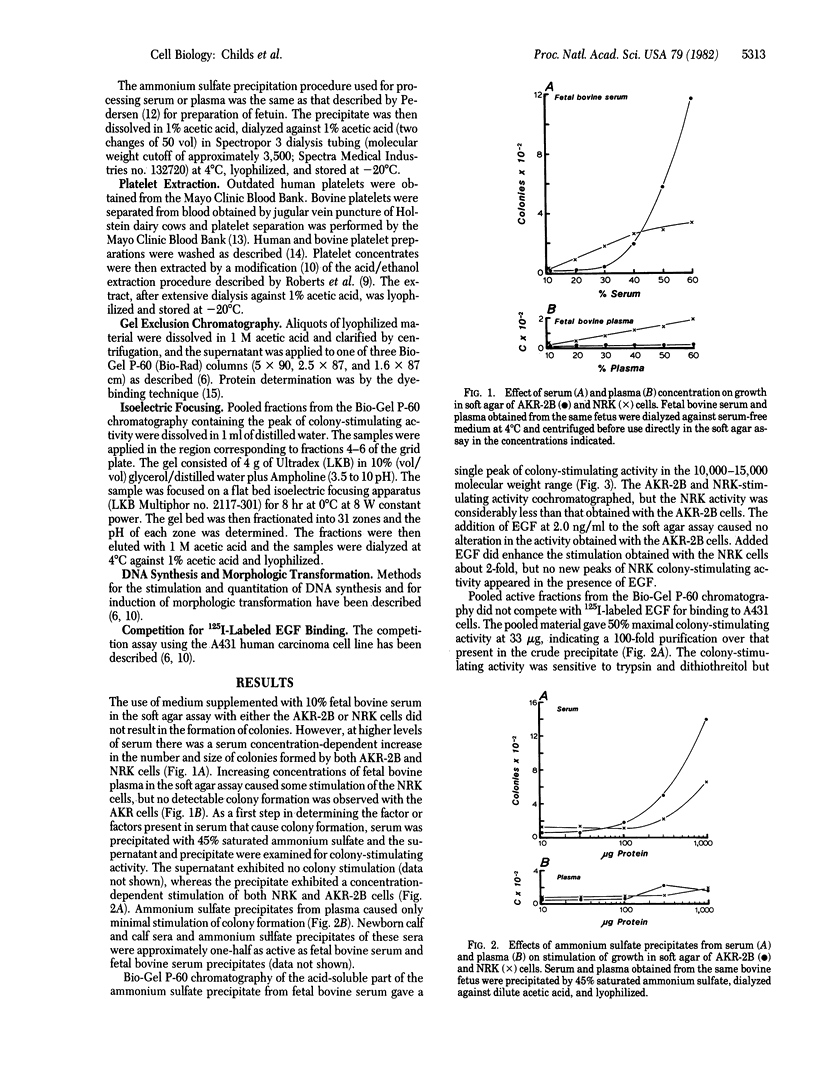
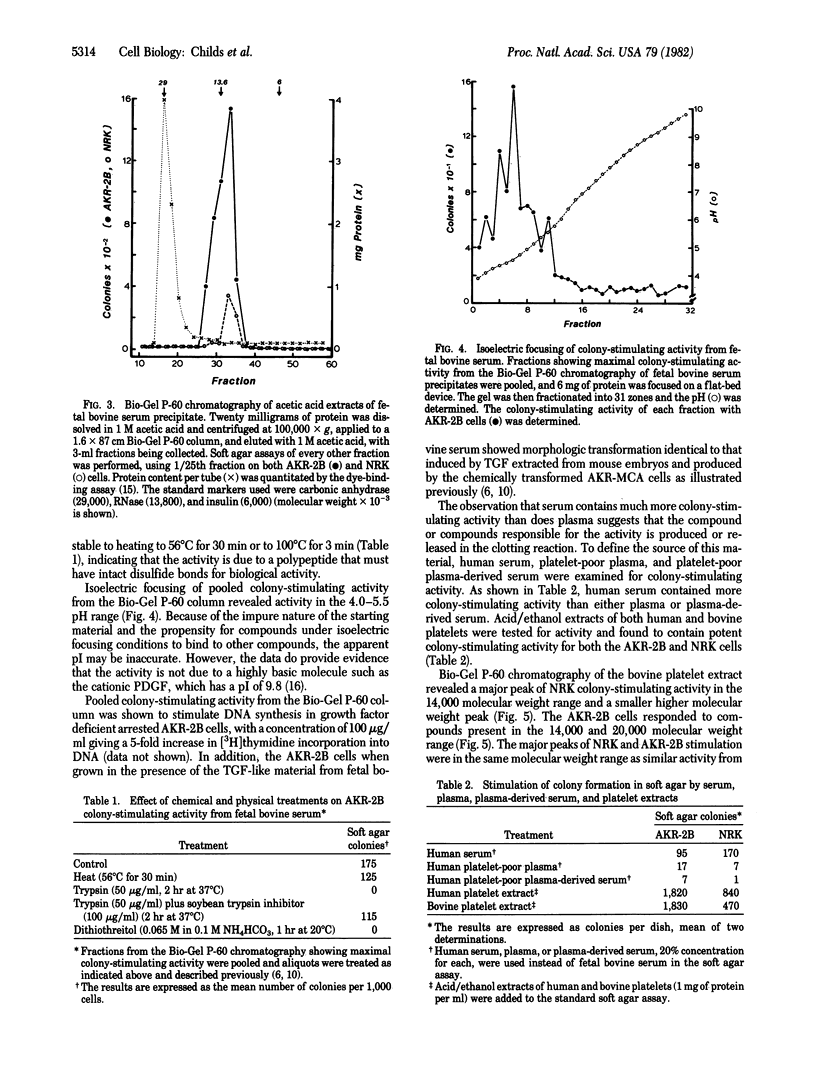
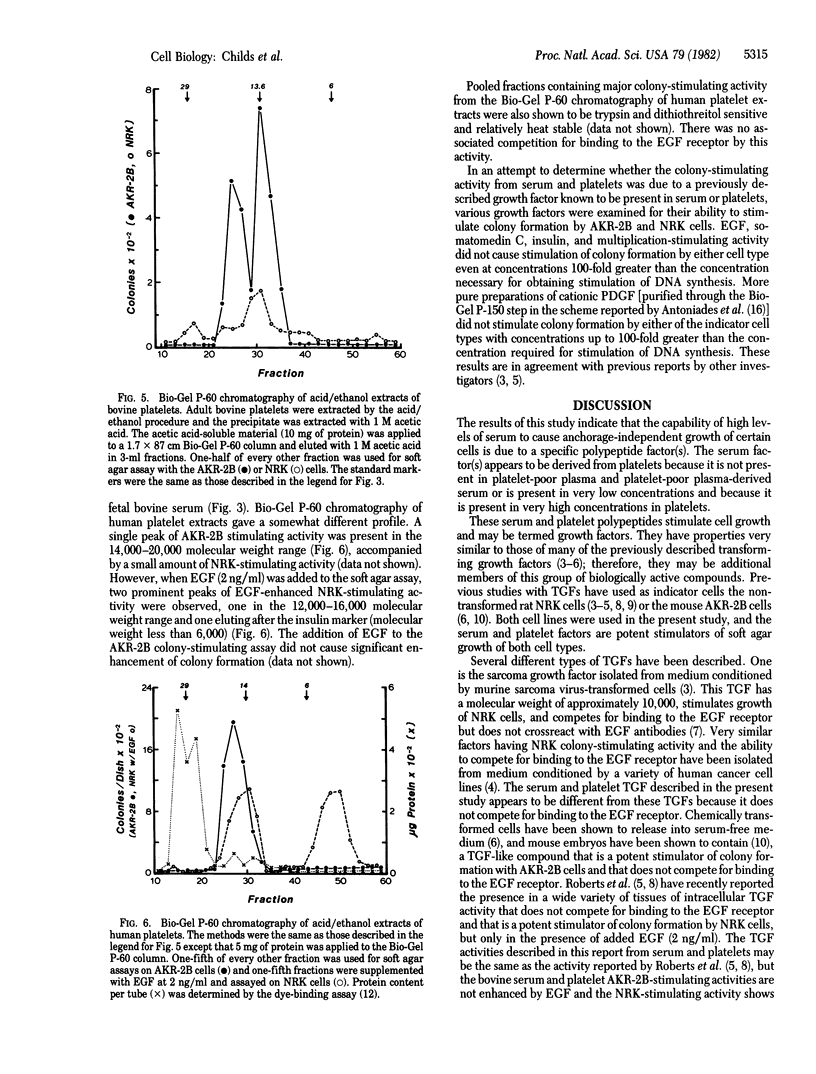
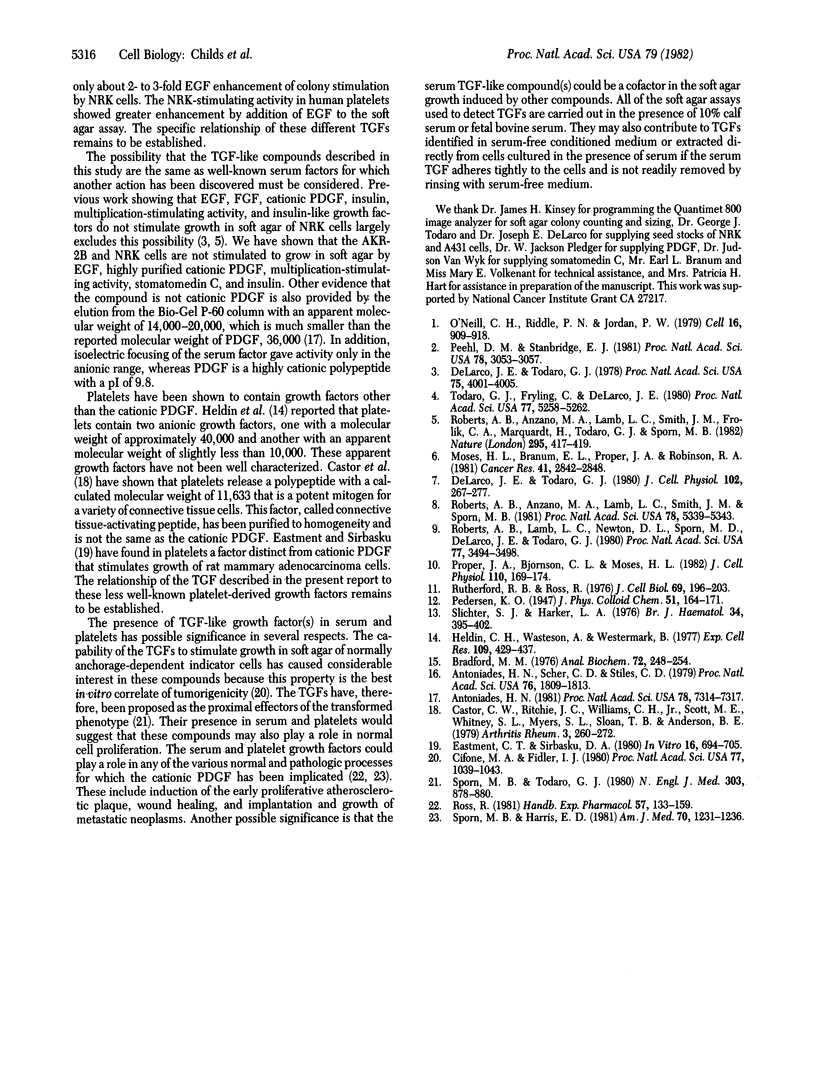
Selected References
These references are in PubMed. This may not be the complete list of references from this article.
- Antoniades H. N. Human platelet-derived growth factor (PDGF): purification of PDGF-I and PDGF-II and separation of their reduced subunits. Proc Natl Acad Sci U S A. 1981 Dec;78(12):7314–7317. doi: 10.1073/pnas.78.12.7314. [DOI] [PMC free article] [PubMed] [Google Scholar]
- Antoniades H. N., Scher C. D., Stiles C. D. Purification of human platelet-derived growth factor. Proc Natl Acad Sci U S A. 1979 Apr;76(4):1809–1813. doi: 10.1073/pnas.76.4.1809. [DOI] [PMC free article] [PubMed] [Google Scholar]
- Bradford M. M. A rapid and sensitive method for the quantitation of microgram quantities of protein utilizing the principle of protein-dye binding. Anal Biochem. 1976 May 7;72:248–254. doi: 10.1016/0003-2697(76)90527-3. [DOI] [PubMed] [Google Scholar]
- Castor C. W., Ritchie J. C., Williams C. H., Jr, Scott M. E., Whitney S. L., Myers S. L., Sloan T. B., Anderson B. E. Connective tissue activation. XIV. Composition and actions of a human platelet autacoid mediator. Arthritis Rheum. 1979 Mar;22(3):260–272. doi: 10.1002/art.1780220308. [DOI] [PubMed] [Google Scholar]
- Cifone M. A., Fidler I. J. Correlation of patterns of anchorage-independent growth with in vivo behavior of cells from a murine fibrosarcoma. Proc Natl Acad Sci U S A. 1980 Feb;77(2):1039–1043. doi: 10.1073/pnas.77.2.1039. [DOI] [PMC free article] [PubMed] [Google Scholar]
- De Larco J. E., Todaro G. J. Sarcoma growth factor (SGF): specific binding to epidermal growth factor (EGF) membrane receptors. J Cell Physiol. 1980 Feb;102(2):267–277. doi: 10.1002/jcp.1041020218. [DOI] [PubMed] [Google Scholar]
- Eastment C. T., Sirbasku D. A. Human platelet lysate contains growth factor activities for established cell lines derived from various tissues of several species. In Vitro. 1980 Aug;16(8):694–705. doi: 10.1007/BF02619199. [DOI] [PubMed] [Google Scholar]
- Heldin C. H., Wasteson A., Westermark B. Partial purification and characterization of platelet factors stimulating the multiplication of normal human glial cells. Exp Cell Res. 1977 Oct 15;109(2):429–437. doi: 10.1016/0014-4827(77)90023-4. [DOI] [PubMed] [Google Scholar]
- Moses H. L., Branum E. L., Proper J. A., Robinson R. A. Transforming growth factor production by chemically transformed cells. Cancer Res. 1981 Jul;41(7):2842–2848. [PubMed] [Google Scholar]
- O'Neill C. H., Riddle P. N., Jordan P. W. The relation between surface area and anchorage dependence of growth in hamster and mouse fibroblasts. Cell. 1979 Apr;16(4):909–918. doi: 10.1016/0092-8674(79)90106-5. [DOI] [PubMed] [Google Scholar]
- Peehl D. M., Stanbridge E. J. Anchorage-independent growth of normal human fibroblasts. Proc Natl Acad Sci U S A. 1981 May;78(5):3053–3057. doi: 10.1073/pnas.78.5.3053. [DOI] [PMC free article] [PubMed] [Google Scholar]
- Proper J. A., Bjornson C. L., Moses H. L. Mouse embryos contain polypeptide growth factor(s) capable of inducing a reversible neoplastic phenotype in nontransformed cells in culture. J Cell Physiol. 1982 Feb;110(2):169–174. doi: 10.1002/jcp.1041100210. [DOI] [PubMed] [Google Scholar]
- Roberts A. B., Anzano M. A., Lamb L. C., Smith J. M., Frolik C. A., Marquardt H., Todaro G. J., Sporn M. B. Isolation from murine sarcoma cells of novel transforming growth factors potentiated by EGF. Nature. 1982 Feb 4;295(5848):417–419. doi: 10.1038/295417a0. [DOI] [PubMed] [Google Scholar]
- Roberts A. B., Anzano M. A., Lamb L. C., Smith J. M., Sporn M. B. New class of transforming growth factors potentiated by epidermal growth factor: isolation from non-neoplastic tissues. Proc Natl Acad Sci U S A. 1981 Sep;78(9):5339–5343. doi: 10.1073/pnas.78.9.5339. [DOI] [PMC free article] [PubMed] [Google Scholar]
- Roberts A. B., Lamb L. C., Newton D. L., Sporn M. B., De Larco J. E., Todaro G. J. Transforming growth factors: isolation of polypeptides from virally and chemically transformed cells by acid/ethanol extraction. Proc Natl Acad Sci U S A. 1980 Jun;77(6):3494–3498. doi: 10.1073/pnas.77.6.3494. [DOI] [PMC free article] [PubMed] [Google Scholar]
- Rutherford R. B., Ross R. Platelet factors stimulate fibroblasts and smooth muscle cells quiescent in plasma serum to proliferate. J Cell Biol. 1976 Apr;69(1):196–203. doi: 10.1083/jcb.69.1.196. [DOI] [PMC free article] [PubMed] [Google Scholar]
- Slichter S. J., Harker L. A. Preparation and storage of platelet concentrates. I. Factors influencing the harvest of viable platelets from whole blood. Br J Haematol. 1976 Nov;34(3):395–402. doi: 10.1111/j.1365-2141.1976.tb03586.x. [DOI] [PubMed] [Google Scholar]
- Sporn M. B., Harris E. D., Jr Proliferative diseases. Am J Med. 1981 Jun;70(6):1231–1235. doi: 10.1016/0002-9343(81)90832-9. [DOI] [PubMed] [Google Scholar]
- Sporn M. B., Todaro G. J. Autocrine secretion and malignant transformation of cells. N Engl J Med. 1980 Oct 9;303(15):878–880. doi: 10.1056/NEJM198010093031511. [DOI] [PubMed] [Google Scholar]
- Todaro G. J., Fryling C., De Larco J. E. Transforming growth factors produced by certain human tumor cells: polypeptides that interact with epidermal growth factor receptors. Proc Natl Acad Sci U S A. 1980 Sep;77(9):5258–5262. doi: 10.1073/pnas.77.9.5258. [DOI] [PMC free article] [PubMed] [Google Scholar]
- de Larco J. E., Todaro G. J. Growth factors from murine sarcoma virus-transformed cells. Proc Natl Acad Sci U S A. 1978 Aug;75(8):4001–4005. doi: 10.1073/pnas.75.8.4001. [DOI] [PMC free article] [PubMed] [Google Scholar]


